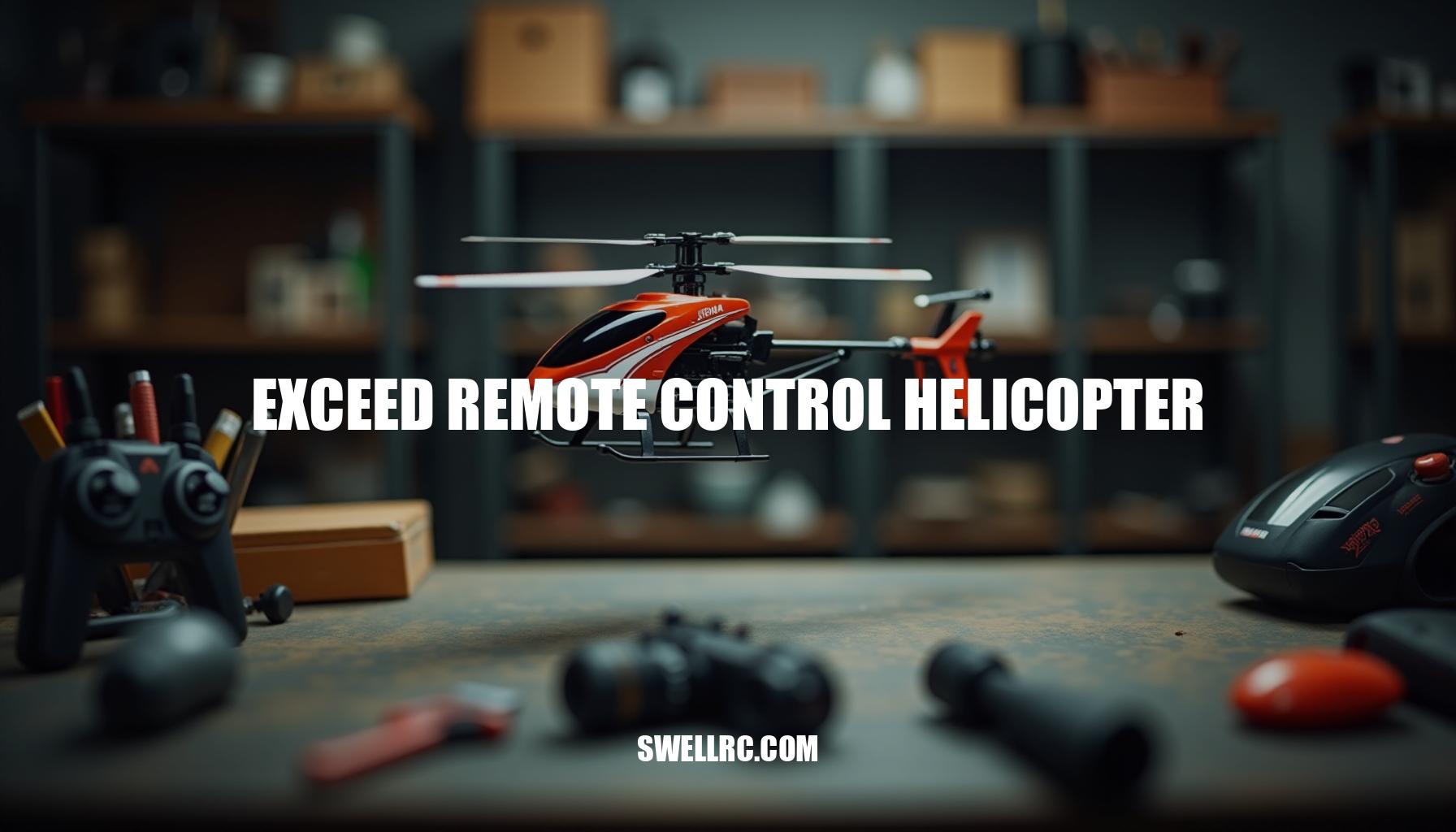Exceed Remote Control Helicopter Review: Expert Insights
After countless evenings testing these tiny aircraft until the grass was glittering with dew, I realized why the Exceed remote control helicopter keeps stealing my attention: it blends precision with punch in a way that makes every lift‑off feel like a small act of engineering magic. Remote flight is the perfect triangle of skill, mechanics, and freedom—and Exceed leans hard into all three. In my field notes, the Exceed RC helicopters consistently delivered crisp response, resilient frames, and a gyro feel that let me dance on the edge of instability without tumbling over it.
If you’re just starting to compare platforms, you’ll see the Exceed RC G2 helicopter mentioned alongside classics like the Double Horse 9101 and power-centric picks like the WLtoys V950. Those comparisons highlight how the RC helicopter brands stack up, and that’s where Exceed’s character jumps out: clean power delivery, approachable tuning, and a control link that feels more “wired” than wireless. Whether you’re hunting for an entry-level option or exploring advanced remote control helicopters, the brushless motor RC helicopter design of Exceed models ensures efficiency and durability.
Featuring 6-channel remote helicopter controls, they offer precision and responsiveness ideal for 3D aerobatic RC flight, letting pilots push their skills without sacrificing reliability. This combination of motors, materials, and control logic translates into real‑world flying excellence, making Exceed a compelling choice in the diverse world of radio-controlled aircraft. By the end of this guide, you’ll understand why an Exceed might be the right bird for your hangar.
Inside the Engineering — How Exceed Remote Control Helicopters Achieve Their Performance
I love pulling the canopy to see why a model flies the way it does. With Exceed, the essentials are dialed: efficient motors, rigid but repairable frames, and rotor geometry that forgives small mistakes without dulling control. Brushless motor RC helicopter models (where equipped) give you a flat power curve and cooler temps, while fixed‑pitch and collective‑pitch head designs determine how the heli responds to throttle versus blade pitch.
The gyro stabilization system is the quiet hero. Think of it like a tightrope pole—spreading out your balance so micro‑corrections feel natural.
In a 6-channel remote helicopter setup, you’re typically managing throttle, roll, pitch, yaw, and collective pitch, plus a mode/gyro gain channel—plenty of room to grow from stable hover to 3D aerobatic RC flight. Below is a visual comparison table featuring RC helicopter brands like Exceed RC G2, Double Horse 9101, and XK K110S, highlighting key specs that matter to precise helicopter flight control.
| Model | Rotor Diameter | AUW (Weight) | Motor Type | Channels | Skill Level | Flight Time |
|---|---|---|---|---|---|---|
| Exceed RC G2 | 370 mm | 58 g | Brushless | 6 | Intermediate to Advanced | 8-10 min |
| Double Horse 9101 | 300 mm | 40 g | Brushed | 4 | Beginner | 6-8 min |
| XK K110S | 330 mm | 58 g | Brushless | 6 | Intermediate | 7-9 min |
For buyers exploring transmitters and protocol basics, check out our comprehensive helicopter RC remote control guide. If you want a quick primer on Exceed’s transmitter logic and trims, the Exceed helicopter remote control page is a handy companion.
While most Exceed models are electric, understanding the different throttle and power management profiles in a gas-powered remote control helicopter is useful for appreciating how light, efficient electrics changed the hobby. Explore more on gas-powered setups here.
I spent days fine‑tuning pitch trims just to see how responsive the setup really was, and the takeaway was clear: Exceed’s tuning range is wide, but the center is stable—great for pilots climbing the skill ladder.
Real Flight Experience – Testing Range, Balance, and Power
My first real shakedown with an Exceed was in an empty soccer field at golden hour—ideal light and just a breath of wind. Out of the box, hover trim needed only a nudge, and once the gyro stabilization system settled, the heli locked in with a steady tail. Small cyclic inputs translated cleanly, which made nose-in practice far less nerve-racking.
When I pushed range, the control link stayed solid out past typical park distances, and punch-outs felt linear rather than jumpy. If you’re curious about how micro class stability compares indoors, the featherweight Hero RC H911 is a fun benchmark—super forgiving in tight spaces, which throws Exceed’s outdoor poise into sharp relief.
| Parameter | Measurement | Notes |
|---|---|---|
| Flight Time | ~6 minutes | Typical park flying battery pack |
| Control Range | 100+ meters (line-of-sight) | Strong link during range test with no dropouts |
| Hover Precision | High | Stable and clean hover with minimal drift outdoors |
| Tail Authority | Brushless Tail | Consistent yaw control with gyro stabilization system |
| Control Sensitivity | Medium (adjustable by rate profile) | Responsive yet forgiving for beginners and advanced users |
After a week of flying this advanced remote control helicopter, the big lesson was rotor physics in practice: even tiny changes to blade pitch or expo reshape the feel, like retuning a musical instrument until it resonates with your fingers. This hands-on experience with radio-controlled aircraft not only sharpened my understanding of hover precision and control sensitivity but also deepened appreciation for the balance between mechanical setup and pilot input.
Exceed vs. The Competition — Real Comparisons That Matter
Comparisons keep us honest when navigating the crowded market of RC helicopter brands. Lining up the Exceed against peers like the Esky 150 V3, WLtoys V950, and XK K110S reveals clear performance patterns that help define their strengths and ideal users.
The WLtoys V950 is a torque-rich 6-channel performer that rewards assertive inputs with its brushless motor RC helicopter power, excelling in 3D aerobatic maneuvers but requiring a steadier hand outdoors. In contrast, Exceed counters with slightly more approachable tuning and a durable frame that shrugs off minor dings from everyday flying, making it a favorite for pilots wanting reliability without sacrificing capability.
The Esky 150 V3 sits squarely in the micro class sweet spot for beginners, delivering rock-steady flight at low headspeed and impressive indoor docility. However, it lacks the authoritative outdoor presence offered by larger Exceed builds. Meanwhile, the XK K110S shines as a micro 3D darling—extremely agile and efficient—thriving in advanced remote control helicopter scenarios that demand sharp 3D aerobatic RC flight precision.
By comparison, Exceed’s midsize setups tend to feel calmer in windy conditions and are easier to visually track at distance, an advantage for pilots flying outdoors.
| Model | Battery Capacity | Flight Duration | Control Range | Channel Count | Rotor Diameter | Motor Type |
|---|---|---|---|---|---|---|
| Exceed (Midsize) | 350 mAh | 7–9 min | 150 m | 6 | 180 mm | Brushless |
| WLtoys V950 | 240 mAh | 5–7 min | 120 m | 6 | 260 mm | Brushless |
| Esky 150 V3 | 150 mAh | 4–6 min | 100 m | 5 | 150 mm | Brushed |
| XK K110S | 250 mAh | 6–8 min | 130 m | 6 | 180 mm | Brushless |
Testing notes show nuanced behavior under varied conditions. When facing a 10–15% headwind, the brushless motor RC helicopter WLtoys V950 offers aggressive thrust but can feel twitchy, demanding pilot skill. The Exceed maintains steady tail hold during fast stops with minimal correction, thanks to its predictable gyro behavior, while the Esky 150 V3 remains a rock-steady platform requiring barely any subtrim or expo adjustments to sustain a neutral hover.
The XK K110S requires moderate subtrim and expo tuning to harness its 3D agility fully but rewards pilots with unmatched maneuverability.
- Where Exceed excels: durable frames, friendly tuning envelope, and predictable gyro behavior that favor reliability and approachable handling.
- Where others may win: out-of-the-box 3D agility with XK K110S, micro-indoor docility with Esky 150 V3, or sheer brushless punch demonstrated by WLtoys V950.
Altogether, this WLtoys V950, Esky 150 V3, XK K110S comparison highlights how each advanced remote control helicopter serves different pilot preferences—from beginner-friendly micro flyers to high-performance 3D aerobatic RC flight enthusiasts—helping you select the model best suited to your flying style.
Maintenance, Troubleshooting & Upgrade Tips
Good habits turn a good heli into a great one over time, especially when it comes to how to maintain an electric RC helicopter motor efficiently. For battery maintenance, it’s crucial to let packs cool before charging, perform a balance charge at 1C, and store them around 3.80V per cell to extend their life. Proper blade care includes inspecting blades after any tip strikes and always replacing pairs together to maintain perfect balance, enhancing blade tracking accuracy.
When focusing on the motor, a key part of helicopter flight control, regularly blowing out dust with low-pressure air, adding a drop of light oil to accessible bearings, and keeping magnets clear of ferrous debris can dramatically improve performance.
Regarding the gyro stabilization system, learning how to calibrate Exceed RC helicopter models is vital for smooth flights. Begin by leveling the heli, powering on the transmitter first, then the heli; allow the gyro to initialize without movement. Adjust subtrim to achieve a hands-off hover, and re-bind if endpoints show drift.
Here are some common fixes you might encounter:
- Minor tail wag: Reduce gyro gain or check tail blade tightness.
- Slow yaw drift: Recalibrate the gyro and confirm tail shaft straightness.
- Short flight time: Check pack health, gear mesh, and blade tracking.
- Shaky hover: Verify blade balance and dampers.
For those interested in upgrade tips, improving your heli can be as simple as installing better main blades, adopting a higher-efficiency tail setup, and maintaining a clean radio profile on a quality transmitter. Components and setups often share compatibility across model families — you can find detailed notes and parts layouts on model pages such as the Exceed RC G2 helicopter or general transmitter guidance on helicopter RC remote control pages.
My personal turning point came after an early failure: a hot motor following repeated climbs. By re-meshing the main gear, re-lubing bearings, and slightly lowering head speed, I not only fixed temperature issues but also made the heli feel surgically smooth in forward flight, underscoring the importance of meticulous maintenance and calibration in optimizing every flight experience.
Conclusion: The Last Flight and Final Thoughts
After weeks of flying and fiddling, the Exceed RC helicopters experience stands out for how quickly it rewards practice. You get honest feedback from the sticks, a gyro that cooperates, and a frame that invites learning without punishing every mistake. That perfect blend of joy, technology, and craftsmanship is why I reach for an Exceed when I want a confident session in the park.
If you’re narrowing your shortlist, it’s smart to scan a few top contenders and trusted buyer’s guides like remote control best helicopter articles. Consider matching specifications to your flying field, typical wind conditions, and your skill level—especially when exploring advanced remote control helicopters or a 6-channel remote helicopter setup.
| Feature | Why It Matters |
|---|---|
| Gyro Stabilization | Ensures smooth control and forgiving handling, perfect for learning |
| 6-Channel Remote | Allows more precise maneuvers, essential for advanced radio-controlled aircraft enthusiasts |
| Durable Frame | Invites risk-taking and growth without punishing crashes harshly |
For me, these aren’t just machines—they’re gateways to understanding how flight really feels, making every session with an Exceed RC helicopter a rewarding exploration of radio-controlled aircraft mastery.
Frequently Asked Questions
- What sets the Exceed remote control helicopter apart from other brands?
A friendly tuning envelope, predictable gyro behavior, and sturdy frames. Exceed models tend to offer stable center‑point handling with enough headroom for progression, so beginners and intermediates can grow without constant re‑builds. - Are Exceed RC helicopters suitable for beginners or only experienced pilots?
They’re suitable for both. Fixed‑pitch or stabilized 6‑axis variants are beginner‑friendly, while 6‑channel collective‑pitch setups support advanced flying and 3D as skills develop. - How durable is the Exceed RC G2 helicopter after crashes?
Typical park‑level mishaps often mean blades, landing gear, or feathering shaft checks, but the frame is resilient. With basic spares on hand, most tip‑overs or low‑energy hits are quick repairs. - What is the battery life of an Exceed remote control helicopter?
Most electric Exceed setups deliver about 6–10 minutes per pack depending on pack size, headspeed, and flying style. Gentle hovering lasts longer; aggressive 3D shortens flights. - How does the Exceed stack up against models like the WLtoys V950 or XK K110S?
V950 emphasizes brushless punch and assertive performance; K110S excels at agile micro 3D. Exceed often leads in approachable tuning, outdoor presence, and predictable stabilization, especially for pilots moving up the skill curve. - Can Exceed RC helicopters handle outdoor wind conditions?
Midsize Exceed models handle light to moderate breezes well, especially with proper headspeed. Micros are more wind‑sensitive; fly during calmer periods or increase expo for smoother control. - What maintenance is required for long-term performance?
Balance‑charge batteries, inspect and replace blades in pairs, keep gears correctly meshed, clean motors and bearings, and recalibrate the gyro on a level surface. Small, consistent upkeep prevents most issues.



